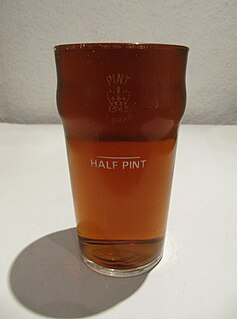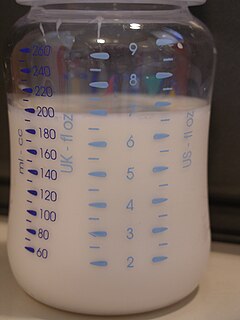Related Research Articles

The imperial system of units, imperial system or imperial units is the system of units first defined in the British Weights and Measures Act 1824 and continued to be developed through a series of Weights and Measures Acts and amendments.

Metrication or metrification is the act or process of converting to a metric system of measurement. All over the world, nations have transitioned from their local and traditional units of measurement to the metric system. This process began in France during the 1790s and continues more than two centuries later. The metric system has not been fully adopted in all countries and sectors.
The pound or pound-mass is a unit of mass used in British imperial and United States customary systems of measurement. Various definitions have been used; the most common today is the international avoirdupois pound, which is legally defined as exactly 0.45359237 kilograms, and which is divided into 16 avoirdupois ounces. The international standard symbol for the avoirdupois pound is lb; an alternative symbol is lbm, #, and ℔ or ″̶.

United States customary units form a system of measurement units commonly used in the United States and U.S. territories since being formalized in 1832. The United States customary system developed from English units which were in use in the British Empire before the U.S. became an independent country. The United Kingdom's system of measures was overhauled in 1824 to create the imperial system, which was officially adopted in 1826, changing the definitions of some of its units. Subsequently, while many U.S. units are essentially similar to their imperial counterparts, there are significant differences between the systems.

The yard is an English unit of length, in both the British imperial and US customary systems of measurement, that comprises 3 feet or 36 inches. Since 1959 it is by international agreement standardized as exactly 0.9144 meter. A distance of 1,760 yards is equal to 1 mile.

The pint is a unit of volume or capacity in both the imperial and United States customary measurement systems. In both of those systems it is traditionally one eighth of a gallon. The British imperial pint is about 20% larger than the American pint because the two systems are defined differently. Almost all other countries have standardized on the metric system, so the size of what may be called a pint, from the French la pinte, varies depending on local custom.

A bushel is an imperial and US customary unit of volume based upon an earlier measure of dry capacity. The old bushel is equal to 2 kennings (obsolete), 4 pecks, or 8 dry gallons, and was used mostly for agricultural products, such as wheat. In modern usage, the volume is nominal, with bushels denoting a mass defined differently for each commodity.

Metrication is the process of introducing the International System of Units, also known as SI units or the metric system, to replace a jurisdiction's traditional measuring units. Although U.S. customary units have been defined in terms of metric units since the 19th century, as of 2021 the United States is one of only three countries that have not officially adopted the metric system as the primary means of weights and measures.

The Quarter Pounder is a hamburger sold by international fast food chain McDonald's, so named for containing a patty with a precooked weight of a quarter of a pound (113.4 g). It was first introduced in 1971. In 2013, the Quarter Pounder was expanded to represent a whole line of hamburgers that replaced the company's discontinued Angus hamburger. In 2015, McDonald's increased the precooked weight to 4.25 oz (120 g).

Metrication in Canada began in 1970 and ceased in 1985. While Canada has converted to the metric system for many purposes, there is still significant use of non-metric units and standards in many sectors of the Canadian economy and everyday life today. This is mainly due to historical ties with the United Kingdom, the traditional use of the imperial system of measurement in Canada, proximity to the United States, and strong public opposition to metrication during the transition period.

Metrication in the United Kingdom, the process of introducing the metric system of measurement in place of imperial units, has made steady progress since the mid-20th century but today remains equivocal and varies by context. Most of government, industry and commerce use metric units, but imperial units are officially used to specify journey distances, vehicle speeds and the sizes of returnable milk containers, beer and cider glasses. Imperial units are also often used to describe body measurements and vehicle fuel economy. In schools metric units are taught and used as the norm. Imperial units that remain in common usage in the UK are also taught.

Metrication in the Republic of Ireland happened mostly in the 20th century and was officially completed in 2005, with a few exceptions.

Both the British Imperial and United States customary systems of measurement derive from earlier English systems used in the Middle Ages, that were the result of a combination of the local Anglo-Saxon units inherited from Germanic tribes and Roman units brought by William the Conqueror after the Norman Conquest of England in 1066.
There are a number of Spanish units of measurement of length or area that are virtually obsolete due to metrication. They include the vara, the cordel, the league and the labour. The units of area used to express the area of land are still encountered in some transactions in land today.

Weights and measures acts are acts of the British Parliament determining the regulation of weights and measures. It also refers to similar royal and parliamentary acts of the Kingdoms of England and Scotland and the medieval Welsh states. The earliest of these were originally untitled but were given descriptive glosses or titles based upon the monarch under whose reign they were promulgated. Several omnibus modern acts are entitled the Weights and Measures Act and are distinguished by the year of their enactment.
Chile adopted the metric system in 1848. Previously, the Spanish system of measures was used.
In Guatemala the metric system is official but it uses a mixture of U.S., metric and Spanish customary units.

Portuguese customary units were used in Portugal, Brazil and other parts of the Portuguese Empire until the adoption of the metric system in the 19th century.
Sweden decided to adopt the metric system in 1876. After a ten-year transition period starting 1879, the use of legacy units was outlawed by the beginning of 1889.
The Exchequer Standards may refer to the set of official English standards for weights and measures created by Queen Elizabeth I, and in effect from 1588 to 1826, when the Imperial Units system took effect, or to the whole range of English unit standards maintained by the Court of the Exchequer from the 1200s, or to the physical reference standards physically kept at the Exchequer and used as the legal reference until the such responsibility was transferred in the 1860s, after the Imperial system had been established.
References
- ↑ Proyecto Historia UNI, Universidad Nacional de Ingeniería, Eduardo J. de Habich , chapter 12: Comisión de Pesos y Medidas Archived 2008-10-21 at the Wayback Machine (in Spanish)
- ↑ Sistema legal de unidades de medida del Perú, Ley 23560 (in Spanish)
- ↑ La República, "Mamacoca" recorre sus dominios... (in Spanish)
- ↑ La República, En Feria de la Mujer Emprendedora presentan antibióticos naturales saludables (in Spanish)